The Status Quo, Opportunity and Approach—the Development of Ethnic Minorities in the Context of the Belt and Road Initiative
Ren Weide*
Since China initiated its Reform and Opening-up, particularly with the launch of the Western Development strategy, its ethnic minorities, especially those in western China, have witnessed rapid development of economy, culture, education,science & technology and healthcare, and subsequently made huge achievements and progress. Yet, compared with eastern coastal regions, ethnic minority communities in western China have developed slowly. Although the development gap betweeneastern and western China is narrowing, it is still substantial when it comes to economic and social strengths.
1. Analysis of the ethnic minority development in contemporary China
Ethnic minority development in this paper mainly refers to the ethnic minority development in contemporary China. It covers the development of economy, education, culture, science & technology and healthcare in ethnic minority communities and regions. It aims to bridge the development gap between ethnic minority regions in western China and the more advanced regions in central China and along the eastern coast, and promote common development and prosperity of all people. China is a multi-ethnic country, with the Han ethnic group being the majority and the other 55 ethnic groups being the minority. Ethnic regions mainly refer to the ten provincial-level administrative regions inhabited by ethnic minorities in western China.To be more precise, the ten regions respectively are Inner Mongolia, Xinjiang, Ningxia, Guangxi,Tibet, Gansu, Qinghai, Yunnan, Guizhou and Sichuan.①As a multi-ethnic country, China is home to 55 ethnic minorities. The sixth national census in 2010 revealed that the ethnic minority population was 106.43 million, accounting for 8.41% of the total population. The regional autonomous areas of ethnic minorities include five autonomous regions, 30 autonomous prefectures and 120 autonomous counties (banners). The ten provinces and autonomous regions of Inner Mongolia, Xinjiang, Tibet, Sichuan, Guizhou, Yunnan,Guangxi, Gansu, Qinghai and Ningxia accommodated ethnic minorities which bear 87.9% of the population of all regional autonomous regions and 86.9% of the whole Chinese minority population.Ethnic minority development is in the fundamental interest of ethnic minorities and also the fundamental interest of the Chinese nation. It inevitably echoes the call of China’s development of socialist society, modernization, the building of a harmonious socialist society, as well as the realization of the Chinese Dream (i.e. the great rejuvenation of the Chinese nation in the 21st Century).
Since China initiated its Reform and Openingup, particularly with the launch of the Western Development strategy at the end of the 20th Century, its ethnic minorities, especially those in western China, have witnessed rapid development of economy, culture, education science and technology and healthcare, and subsequently made huge achievements and progress (see Table 1).
Regarding the comprehensive performanceof ethnic regions in western China in 2015, their combined GDP reached RMB 11,127.98 billion,which was 8.98 times that of 1999 (RMB 1,238.67 billion); their fiscal revenue (revenue in the general public budgets) reached RMB 1,299.885 billion,which was 15.37 times that of 1999 (RMB 84.584 billion); there were 535 colleges and universities with a total of 4,637,137 enrolled students, which are respectively 2.89 times and 7.81 times those of 1999 (185 colleges and universities with a total of 593,814 enrolled students); there were 3,872 public institutions of culture, arts and cultural relics,which was 1.27 times that of 1999 (3,037); there were 128,774 granted patent approvals in three categories, which was 15.48 times that of 1999(8,321); there were 54,363 hospitals, health centers and clinics with a staff of 2,317,636, which were respectively 2.64 times and 2.04 times those of 1999 (20,555 hospitals, health centers and clinics with a staff of 1,137,000). However, compared with eastern coastal regions,①The eastern coastal regions refer to the 11 provincial-level administrative regions (provinces, autonomous regions and municipalities directly under the Central Government) that are located along the eastern coast of China, which include Liaoning, Hebei, Beijing, Tianjin, Shandong, Jiangsu, Shanghai, Zhejiang, Fujian,Guangdong and Hainan.the ethnic regions in western China are much slower in the development of economy, education, culture, scientific technology, healthcare, and other undertakings (see Table 2).

Table 1 Development of Economy, Education, Culture, Science and Technology, Healthcare in Western China’s Ethnic Regions (1999 & 2015)

Note: Adapted from China Statistical Yearbook 2000 and China Statistical Yearbook 2016, by Bureau of Statistics of the People’s Republic of China.
Regarding the comprehensive performance of the coastal regions in eastern China in 2015,their combined GDP reached RMB 40,165.17 billion, which was 8.36 times that of 1999 (RMB 4,802.369 billion) and meant an increase of RMB 35,362.801 billion; their fiscal revenue reached RMB 4,859.362 billion, which was 14.63 times that of 1999 (RMB 332.161 billion) and meant an increase of RMB 4,527.201 billion; there were 1,105 colleges and universities with a total of 11,218,117 enrolled students, which were respectively 2.29 times and 5.77 times those of 1999 (483 colleges and universities with a total of 1,944,454 enrolled students) and increases of 622 colleges and universities and 9,273,663 students; there were 7,979public institutions of culture, arts and cultural relics,which was twice that of 1999 (3,998) and an increase of 3,918 institutions; there were 1,135,540 granted patent approvals in three categories, which was 20.15 times that of 1999 (56,363) and an increase of 1,079,177; there were 87,364 hospitals, health centers and clinics with a staff of 4,680,300, which were respectively 4.06 times and twice those of 1999(21,518 hospitals, health centers and clinics with a staff of 2,342,000) and increases of 65,846 hospitals,health centers and clinics and 2,338,300 medical employees.
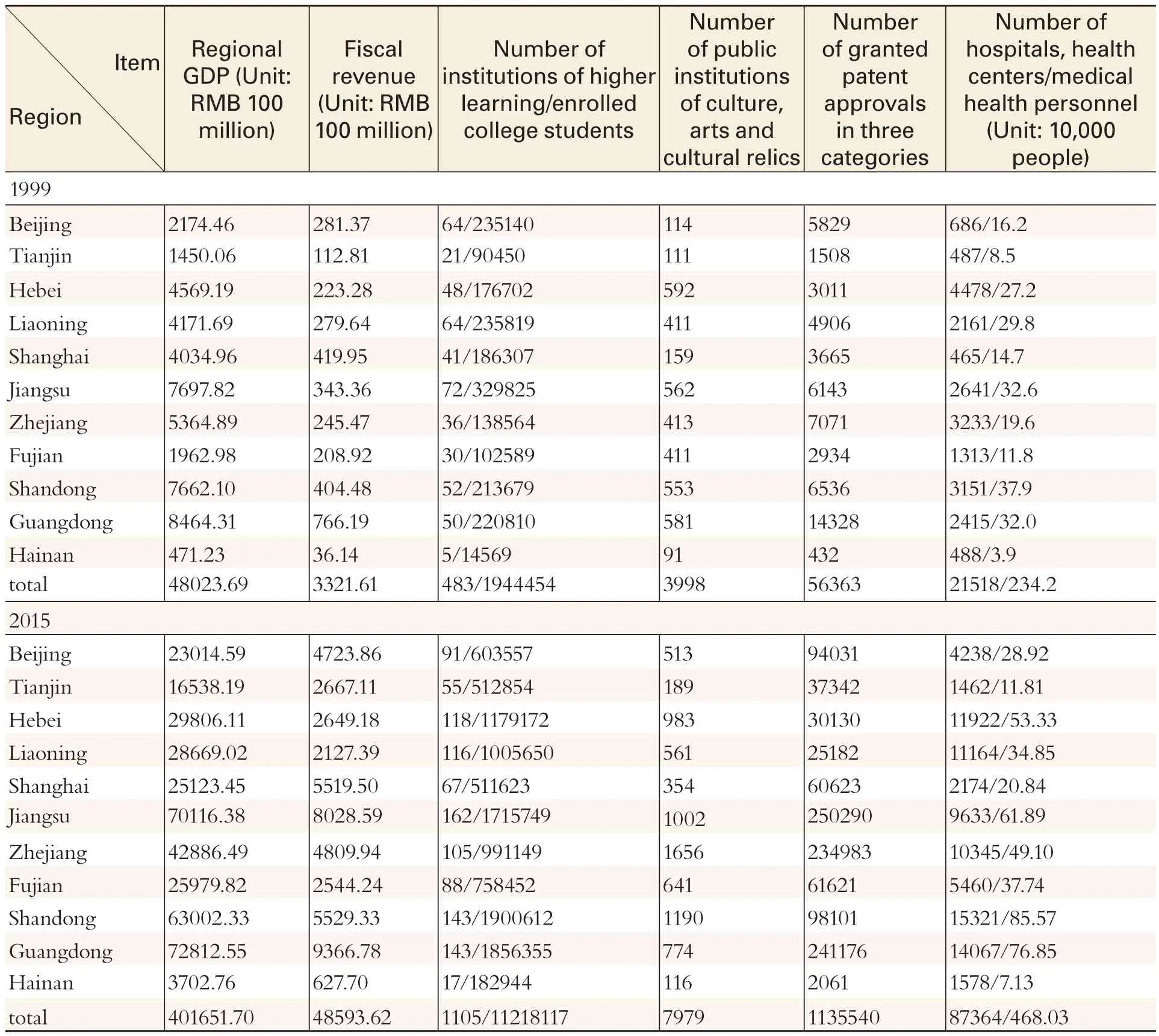
Table 2 Eastern Coastal Regions’ Development of Economy, Education, Culture, Science and Technology and Healthcare (1999 & 2015)
Overall, the development gap between the coastal regions in eastern China and the ethnic regions in western China has been narrowed,though not at a very significant scale. The development gap between the two areas remains huge. Judging from the performance of economy,education, culture, science & technology and healthcare in 2015, such a development gap was quite prominent (see Table 3).
First, in 2015, China’s GDP reached RMB 60,321.21 billion. Of this figure, the coastal regions in eastern China contributed RMB 40,165.17 billion,accounting for 66.59%, while the ethnic regions in western China contributed only RMB 11,127.98 billion. The contribution of the former was 3.61 times that of the latter.
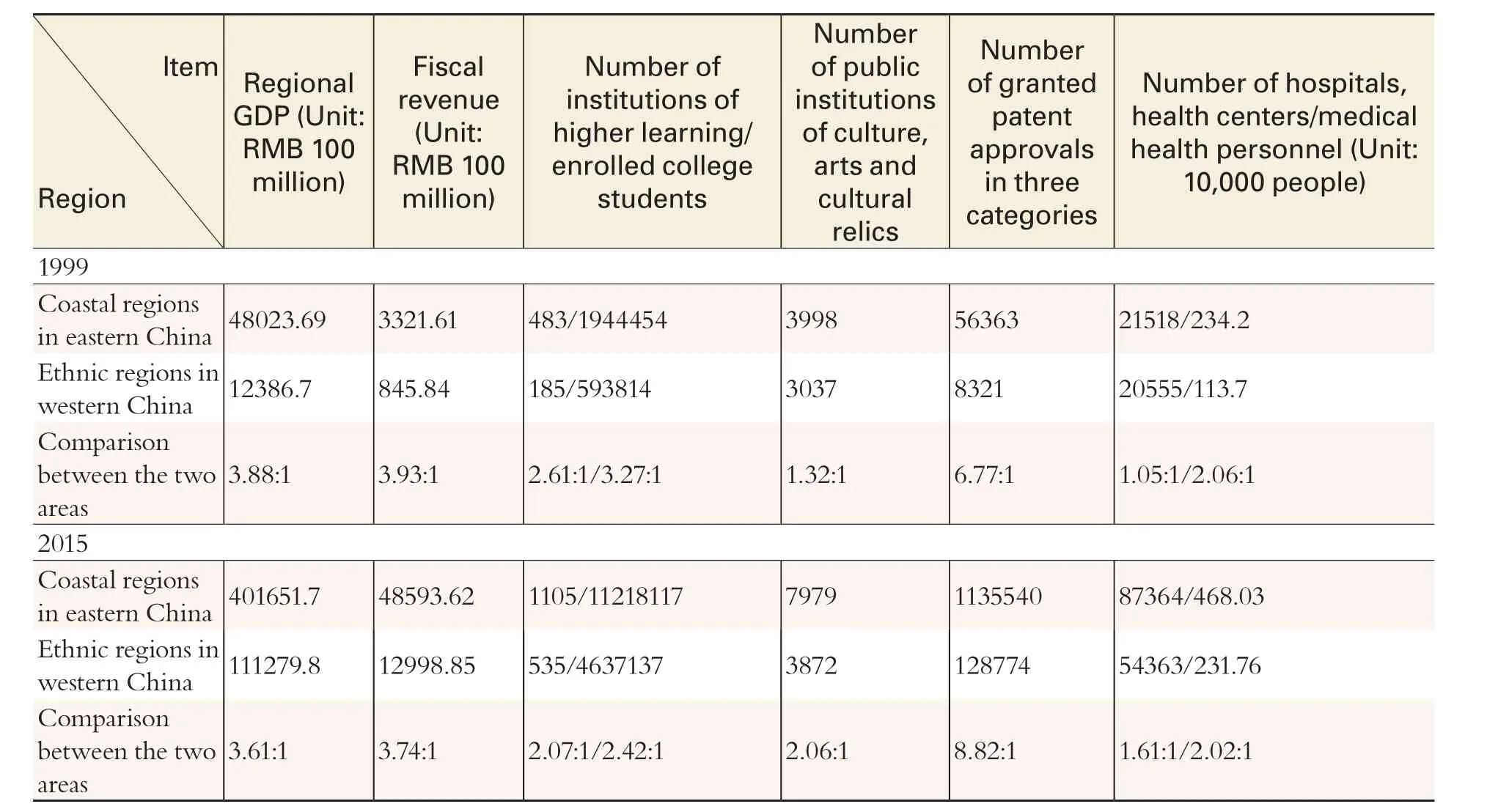
Table 3 Comparison of the Development of Economy, Education, Culture, Science and Technology and Healthcare Between the Ethnic Regions in Western China and Coastal Regions in Eastern China (1999 & 2015)
Second, when it comes to fiscal revenue, the national revenue in the general public budgets was RMB 15,226.923 billion. Of this figure, the coastal regions in eastern China contributed RMB 4,859.362 billion, accounting for 31.91%, while the ethnic regions in western China contributed only RMB 1,299.885 billion. The contribution of the former was 3.74 times that of the latter. Third, in terms of the number of institutions of higher learning and enrolled students, there were 2,560 universities and colleges nationwide, with a total of 26,263,000 enrolled students. More specifically, there were 1,105 colleges and universities with a total of 11,218,117 enrolled students in the coastal regions in eastern China; and 535 colleges and universities with a total of 4,637,137 enrolled students in the ethnic regions in western China. Regarding the two indexes (the number of institutions of higher learning and the number of enrolled college students), the figures of the eastern coastal regions respectively accounted for 43.16% and 42.71% of the national figures and were 2.07 times and 2.42 times those of the ethnic regions in western China.
Fourth, when it comes to the development of cultural undertakings, there were a total of 19,921 public institutions of culture, arts and cultural relics nationwide. Of this figure, the coastal regions in eastern China contributed 7,979, accounting for 31.91%, while the ethnic regions in western China contributed 3,872. The figure of the former was 2.06 times that of the latter.
Fifth, in terms of science and technology development, there were a total of 1,596,977 granted patent approvals in three categories nationwide.Of this figure, the coastal regions in eastern China contributed 1,135,540, accounting for 71.11%; while the ethnic regions in western China contributed 128,774. The figure of the former was 8.82 times that of the latter.
Sixth, regarding the development of healthcare undertakings, there were a total of 208,572 hospitals,health centers and clinics, with a staff of 10,693,900 nationwide. More specifically, there were 87,364 hospitals, health centers and clinics, with a staff of 4,680,300 in the coastal regions in eastern China;and 54,363 with a staff of 2,317,600 in the ethnic regions in western China. Regarding the two indexes (the number of hospitals, health centers and clinics and the number of medical health personnel),the figures of the eastern coastal regions respectively accounted for 41.89% and 43.77% of the national figures and were 1.61 times and 2.02 times those of the ethnic regions in western China.
The ethnic regions in western China, at a slower development pace, lag behind the coastal regions in eastern China. This inevitably causes psychological imbalances among people in those ethnic regions,which challenges contemporary China during its social development and socialist modernization.Such a challenge may endanger its ethnic harmony,national unity and frontier security and directly affect China’s socialist construction, harmonious society building, and the great rejuvenation of the Chinese nation in the 21st Century.
2. New opportunity and guidance for ethnic development brought about by the Belt and Road Initiative
Since the beginning of the Reform and Opening-up, the CPC Central Committee and the State Council have paid close attention to the significant gap between the ethnic regions in western China and the coastal regions in eastern China. To bridge the gap, accelerate the social and economic development of ethnic communities,particularly those in western China, and eventually realize coordinated development among regions,ethnic harmony and frontier stability, they have successively formulated and introduced a number of ethnic community-targeted regional aid policies and regional development strategies, among which are the “pairing assistance” policy and the Western Development strategy. The implementation of the “pairing assistance” policy and the Western Development strategy has significantly enabled the transfer of capital, materials, technology and talents among eastern, central and western China,gradually improved partnerships based on mutual benefit, reciprocity and mutual help, and to some extent adjust the transverse fiscal imbalance. This aid policy and regional development strategy have played an important role in making the most out of the surplus capacities of economic development in eastern coastal regions to boost the economic and social development of the ethnic regions in western China.
Currently, China is advancing the Belt and Road Initiative, which creates a new opportunity of historical significance and provides guidance for the economic and social development of ethnic minority communities, particularly those in western China.
First, the implementation of the Belt and Road Initiative is of strategic significance to boost the economic and social development of ethnic communities (particularly those in western China),bridge regional development gaps, and promote coordinated regional development based on the“connectivity” among regions in eastern, central and western China.
Since the beginning of the Reform and Opening-up, China has witnessed rapid economic development and made remarkable achievements. It has risen to be the world’s second largest economy,significantly having its economic aggregate increased, comprehensive national strength enhanced and people’s living standards improved.However, being a vast multi-ethnic country, China features economic and social imbalances among regions/ethnic communities. The east (i.e. coastal regions in eastern China) has developed much faster than the west (i.e. ethnic regions in western China) and the development gap among regions keeps expanding, thus bringing about a series of new economic and social problems and challenges.Currently, the global economy is struggling to revive; major economies such as the EU, the USA and Japan are looking for a right path to recovery;and the Chinese economy has entered the stage of“New Normal.” In this context, the CPC Central Committee and the State Council, by virtue of their global vision, based on the past and present situations both at home and abroad, duly proposed the Belt and Road Initiative to continue deepening China’s Reform and Opening-up, promote the economic and social development of ethnic communities(particularly those in western China), and enhance regional coordinated development in China. To advance the Belt and Road Initiative, China should give full play to the comparative advantages of different regions, implement more active opening-up strategies, enhance the interactions and cooperation among eastern, central and western China, promote coordinated economic and social development of the three areas, and upgrade the open economy in an allround way. In this regard, China should attach more importance to Western Development strategy and focus on fostering new advantages in international economic and technological cooperation. China should revolve closely around the Belt and Road Initiative, innovate the approaches to the economic and social development for ethnic communities(particularly those in western China), and enhance“connectivity” among the coastal regions in eastern China, regions in central China and ethnic regions in western China. It should highlight the significant role of the Belt and Road Initiative in boosting the economic and social development of the ethnic communities (particularly those in western China),bridging regional development gaps, and promoting coordinated regional development.
Moreover, the implementation of the Belt and Road Initiative is of great significance for the ethnic regions in western China to effectively undertake industrial transfer from the eastern coastal regions,and at the same time create new space for the better practice of regional aid policies and regional development strategies such as the “pairing assistance” policy and the Western Development strategy.
One major objective of the Belt and Road Initiative is to further expand and upgrade the scope of opening-up of the ethnic regions in western China, boost the economic and social development of ethnic communities (particularly those in western China) and thereby bridge the gap between the ethnic regions in western China and the more advanced regions in central China and along the eastern coast. Currently, China is in a process of transferring its labor-intensive sectors from the coastal regions in the east (particularly the southeast)to central and western China. In such a context,the implementation of the Belt and Road Initiative is of great significance for the ethnic regions in western China to effectively undertake the industrial transfer from the eastern coastal regions and boost local economic and social development. The implementation of the Belt and Road Initiative will surely enhance the ties between China’s hinterland(i.e. central and western China, particularly the ethnic regions in western China) and countries in Central and South Asia, as well as Europe. It will effectively help expand the scope of opening-up for ethnic regions in western China and forge a passage to export products made in ethnic regions and across China to international markets such as Central and South Asia and Europe at lower costs. Domestically,it will enable the ethnic regions in western China to undertake the transfer of labor-intensive sectors from the coastal regions in the east (southeast in particular), make the most of local comparative advantages to develop local economies, and upgrade their open economies. That will create new space for the Central Government and local governments in central China and eastern coastal regions to work together to improve and innovate regional aid policies and regional development strategies such as the “pairing assistance” policy and the Western Development strategy under the new historical conditions.
Furthermore, the implementation of the Belt and Road Initiative offers new guidance for local governments of the eastern coastal regions,central China and ethnic regions in western China to enhance coordination and cooperation, and further improve and innovate inter-governmental cooperation models and approaches by means of“connectivity.”
The “connectivity,” which is included in the Belt and Road Initiative, requires innovating regional aid policies and regional development strategies such as the “pairing assistance” policy and the Western Development strategy, enhancing coordination and cooperation among the eastern coastal regions,central China and ethnic regions in western China,working together to advance the Belt and Road Initiative, and upgrading the open economy under the new historical conditions. To this end, first,China should comprehensively push forward the“connectivity” among its eastern, central and western areas in terms of infrastructure construction,system and mechanism improvement, as well as the free flow of capital, technology, talents and information, in a bid to enable regional economic integration, regional coordinated development,cross-region cooperation, reciprocity & mutual benefits, and the exchange of needed goods. Second,China should also properly handle the interests of all parties concerned; identify projects benefiting the“pairing assistance” givers and receivers, or even more parties; extend the fields, scope and content of coordination and cooperation; innovate the models and approaches of coordination and cooperation;and gradually form a virtuous cycle of “pairing assistance.” At the same time, in the context of the Western Development strategy, it needs to advance the economic and technological coordination and cooperation between the coastal regions in eastern China and the ethnic regions in western China in various forms, and enhance the support from economically advanced provinces and municipalities in the eastern coastal regions to the ethnic regions,underdeveloped provinces and impoverished regions in western China. Third, China should accelerate the improvement of its overall layout of the Belt and Road Initiative; engage the local governments of the eastern coastal regions, central China and ethnic regions in western China in the overall planning by concluding an intergovernmental cooperation framework agreement; specify the positioning and responsibilities of relevant provincial-level administrative regions (i.e. provinces, autonomous regions and municipalities directly under the Central Government) belonging to the abovementioned three areas; give full play to their respective comparative advantages; and upgrade the open economy on all fronts by means of coordination and cooperation.
3. Measures and suggestions for ethnic minority development in the context of the Belt and Road Initiative
The Belt and Road Initiative is above all a strategy of “connectivity (Peng & Ren, 2015)” It not only refers to the “connectivity” between China and the rest of the world, but also means going across domestic regions, especially forging “connectivity”among eastern coastal regions, central China and ethnic regions in western China. It is more than the“connectivity” in infrastructure, and widely exists in systems &mechanisms, as well as the free flow of capital, technology, talents and information. Under the new historical conditions, the improvement and innovation of China’s regional aid policies and regional development strategies such as the “pairing assistance” and the Western Development strategy need to be combined with the Belt and Road headway and adhere to the goal of both internal and external “connectivity,” so as to give full play to the due functions of the above-mentioned policies and strategies.
First, China’s regional aid policies and regional development strategies such as the “pairing assistance” policy and the Western Development strategy should go hand in hand with the pursuit of“connectivity” between China and the rest of the world to make them fully functional.
For the past 40 years, China’s Reform and Opening-up, though taking both maritime and land routes, has largely been limited to the Asia Pacific region and Europe, to which China mainly extends through sea routes, with its eastern coastal regions being a solid logistics base. The reason lies in the fact that eastern coastal regions are more advantageous in infrastructure construction (transportation, postal communication, etc.), industrial base, technology,management, education development and ties with the world. Piloting opening-up in the four special economic zones and 14 coastal cities in eastern China was a move to exploit their comparative edges, make better use of external funds,technology, knowledge and markets of developed countries and regions, quicken local enterprises’pace for renovation, transformation and new product development, enhance the competitiveness of their products in the global market, and convert the domestically-oriented economy into a mixed one targeting both domestic and international markets.Those areas were supposed to radiate their influence onto the hinterland of China and push the socioeconomic development of central China and the ethnic regions in western China. By contrast, the opening-up along land routes has lagged, precisely because the pivot of Chinese socio-economic development falls in eastern coastal regions, rather than the less-developed ethnic regions in western China, which are clogged by a weak industrial base,poor infrastructures, and backward transportation and postal communications. In the past, there were not many routes linking these regions to the outside world, let alone the fact that the work of the very routes was hampered due to various domestic and international factors and therefore could only play a limited role. Thanks to nearly forty years of openingup, China has formed an opening-up panorama consisting of sequences of special economic zones, open coastal cities, open riverside cities and open border towns. The Belt and Road Initiative requires further opening-up and outward extension,especially along the land routes, to maximize the external interests of China.
In the near future, the aid projects initiated by the Central Government and the governments of the eastern coastal regions and central China, such as the “pairing assistance” policy and the Western Development strategy, must prioritize infrastructure construction in transportation, communications,pipeline networks and energy supply, to enhance“connectivity” among different regions in China,especially between the ethnic regions in western China and those in central China and along the eastern coast, and pave the way for “connectivity”with the rest of the world. Meanwhile, with the CPC Central Committee and the State Council at the helm, eastern, central and western China should forge partnerships in which their comparative advantages can be fully exploited. The “high-speed railway diplomacy” should be vigorously pushed in a bid to advance the construction of international transport arteries, forge an infrastructure network that connects all Asian sub-regions, and Asia,Europe and Africa. The goal is to press forward on the “connectivity” between China and the rest of the world to break the bottlenecks in traditional transportation, communications, pipeline networks and energy that are restraining China’s land-route opening-up and outward extension.
Second, China’s regional aid policies and regional development strategies such as the “pairing assistance” policy and the Western Development strategy should be combined with the pursuit of“connectivity” among different regions to act more effectively.
Various domestic factors, especially the geographical differentiation and strategy of unbalanced development, have led to socioeconomic growth gaps between different regions of China, especially between eastern coastal regions and ethnic regions in western China.The gaps between western China and central and eastern China, if continuously enlarged, will inevitably affect the “connectivity” between them in infrastructure construction and the free flow of capital, technology, talents and information, the“connectivity” between China and the rest of the world, and eventually the pace of the Belt and Road Initiative. Therefore, the domestic “connectivity” is in fact a process to bridge the gap among regions and balance their development. The “pairing assistance”policy and the Western Development strategy should be further advanced, and the aid to ethnic regions in western China by regions in central China and along the eastern coast should be strengthened to achieve a real “connectivity” between the three and lift the socio-economic growth of ethnic communities(particularly those in western China).
Moreover, China’s regional aid policies and development strategies such as the “pairing assistance” policy and the Western Development strategy should be further improved and innovated in content and forms according to the requirements of domestic and international “connectivity.” Only by doing so can it build a complete state-level system of regional aid policies and make it work to the largest degree.
The “connectivity” between China and the rest of the world should focus on policy coordination, facilitating connectivity, unimpeded trade, financial integration and people-to-people bonds (The National pevelopment and Reform commission, Ministry of Foreign Affairs, and Ministry of Commerce of China, 2015). According to the guidelines made by the CPC Central Committee and the State Council, the “pairing assistance” work should facilitate the cooperation among local governments of eastern, central and western China, the Belt and Road construction and finally the “connectivity” between China and the rest of the world. Domestically, the functions of the “pairing assistance” policy and the Western Development strategy are not only in infrastructure construction, but also in systems and mechanism building, and the free flow of capital, technology,talents and information. The “pairing assistance”and the Western Development strategy must prioritize domestic connectivity to make themselves more effective as strategic policies, i.e. to draw more aid for infrastructure construction, systems and mechanism building, and the introduction of capital, technology, talents and information to the ethnic regions in western China from the eastern coastal regions and central China.
The first thing worth attention is that China’s regional aid policies and development strategies such as the “pairing assistance” policy and the Western Development strategy should be improved and innovated in content and forms while firmly following the requirements of the Belt and Road Initiative and its call for “connectivity.”
The “pairing assistance” policy and the Western Development strategy used to take the forms of disaster relief, economic aid, medical aid, educational aid, the Central Government’s direct policies, as well as the utilization of the surplus economic capacity of the eastern coastal regions as a driver for the socio-economic development of ethnic regions in western China. To link deeper into the Belt and Road Initiative, the aid should be strengthened in systems and mechanisms, which, still backward in the ethnic regions in western China, are keeping a restrictive rein on their development(Peng, 2001).According to a research conducted by Fan Gang,Wang Xiaolu and Yu Jingwen, all famous Chinese scholars in the studies of marketization, in 2014 there was a wide gap in marketization among eastern,central and western China, especially between the ten provincial-level administrative regions inhabited by ethnic minorities in western China and their 11 coastal counterparts in eastern China (as is shown in Table 4).
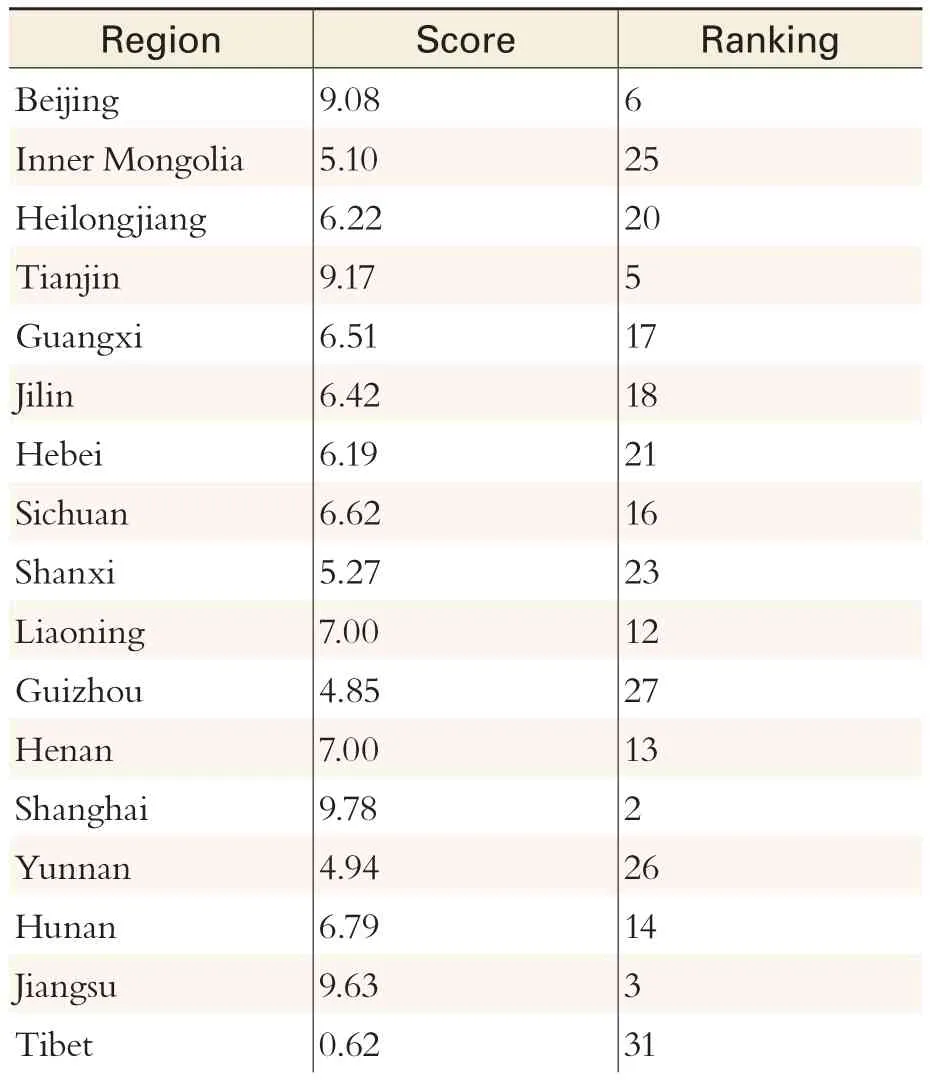
Table 4 Marketization Scores and Rankings of Relevant Provinces, Autonomous Regions and Municipalities Directly Under the Central Government in 2014① More details can be found in Wang Xiaolu, et al.“Report on China's 8-Year Marketization”. Retrieved from: http://finance.qq.com/a/20160414/041777.htm,2016-04-14
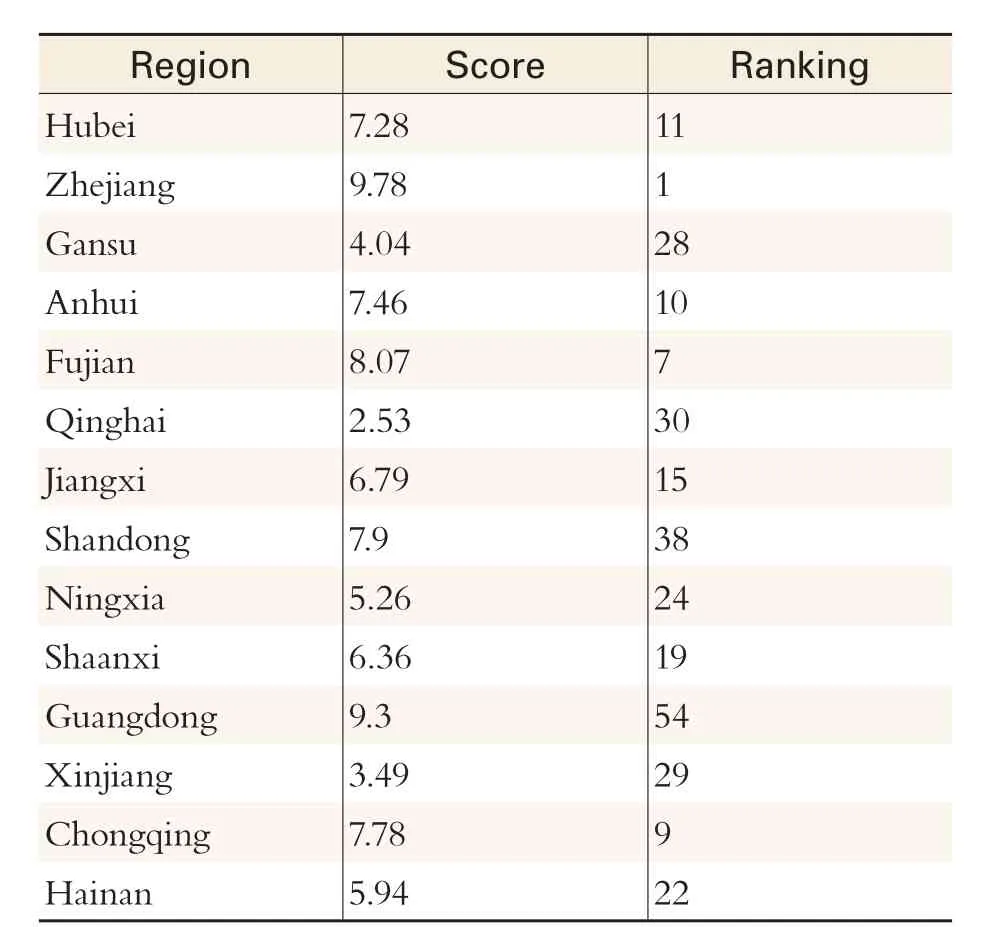
?
Here are the eastern coastal regions listed in descending order of the 2014 marketization index:Zhejiang, Shanghai, Jiangsu, Guangdong, Tianjin,Beijing, Fujian, Shandong, Liaoning, Hebei and Hainan, with their marketization indexes being respectively 9.78, 9.78, 9.63, 9.35, 9.17, 9.08, 8.07, 7.93,7.00, 6.19 and 5.94. By contrast, the marketization indexes of the ethnic regions in western China are lagging. In descending order, they are: Sichuan,Guangxi, Ningxia, Inner Mongolia, Yunnan,Guizhou, Gansu, Xinjiang, Qinghai and Tibet, with their marketization indexes being respectively 6.62,6.51, 5.26, 5.10, 4.94, 4.85, 4.04, 3.49, 2.53 and 0.62.
Set Hebei and Hainan, the last two of the eastern rankings, as the baseline, and it can be seen that among the ten western provinces and autonomous regions, only Sichuan and Guangxi were slightly above the baseline, while the other eight areas were below. Low-level marketization has been a major institutional barrier for the socio-economic development of the ethnic regions in western China.That, alongside all kinds of regional protectionism,hampered the generation of a large, unified domestic market. And “connectivity” under such circumstances remained sheer tokenism. Therefore,in advancing the Belt and Road Initiative, it is necessary to further improve the “pairing assistance”policy and the Western Development strategy, and to increase institutional aid and broaden the scope of the aid both in content and forms. The recommended measures are listed as follows:
First, China should promote two-way communications between eastern and central China(especially the eastern coastal regions) and ethnic regions in western China, and encourage leading officials of the Party and governments at all levels to take office temporarily and trans-regionally while holding their original position to let officials and cadres in western China learn about the more advanced mechanisms from the more developed regions and apply them to their real work. For ethnic regions in western China, institutional innovation is none other than a process of discovering, learning from, imitating and finally exceeding eastern coastal regions.
Second, the Party and government authorities and public institutions at all levels in the ethnic regions in western China should adopt various approaches to send their officials and cadres to central and eastern China, especially to the eastern coastal regions for a certain period to well acquaint them with mature systems and mechanisms.
Third, the training of cadres should be incorporated into the “pairing assistance” policy and the Western Development strategy. The Regulations on Cadre Education and Training issued by the CPC Central Committee stipulates that the training of cadres from ethnic regions in western China is a task of relevant cadre training institutions in eastern and central China, especially those in the eastern coastal regions.
Another aspect worth attention is that intergovernmental cooperation should be strengthened in the cultivation of an open economy and a win-win outcome should be achieved among eastern, western and central China by implementing regional aid policies and development strategies such as the “pairing assistance” policy and the Western Development strategy.
In March 2015, the Vision and Actions on Jointly Building the Silk Road Economic Belt and the 21st-Century Maritime Silk Road was jointly issued by the National Development and Reform Commission, the Ministry of Foreign Affairs, and the Ministry of Commerce of the People’s Republic of China with the authorization of the State Council.According to its stipulation, “In advancing the Belt and Road Initiative, China should fully leverage the comparative advantages of all regions, adopt a proactive strategy of further opening-up, strengthen interactions and cooperation among eastern, central and western China, and comprehensively upgrade its open economy.” Therefore, to identify where the“pairing assistance” and the Western Development strategy can fit into the Belt and Road Initiative and closely link them, China should continue to develop its open economy while promoting governmental interactions and cooperation among the eastern coastal regions, central China and the ethnic regions in western China and completing the transformation of the “pairing assistance” policy and the Western Development strategy.
Since its beginning in 1978, China’s openingup has featured an export-oriented economy, which relies on introducing capital and technology from the developed countries and earning foreign exchange through exports to realize economic development.Forty years on, China has become a major player with solid financial strength and leading technologies in high-speed railway, nuclear power,photovoltaic energy, aerospace, satellite navigation,etc. It now even faces the problem of overcapacity.Given that, there should be a shift in the opening-up away from the mere introduction of foreign capital,technology and increases of the foreign exchange reserve. More importantly, the focus should be placed on letting Chinese capital, technology and surplus industrial supply go global, and invigorating them on the global market to optimize Chinese resources around the world, develop and upgrade its open economy. Considering this, forging ahead with the “pairing assistance” policy and the Western Development strategy and giving full play to their functions require fitting them into the Belt and Road Initiative and enhancing governmental interaction and cooperation among the eastern coastal regions,central China and the ethnic regions in western China. Also, the pursuit and development of an open economy should include efforts to transform the “pairing assistance” policy and the Western Development strategy.
First, China should leverage regional comparative advantages, work together with partners to develop its open economy, and achieve a win-win outcome through partnership. In eastern,central and western China, local governments should make, sign and implement effective cooperation and coordination policies, agreements and measures based on their respective advantages to promote trans-regional cooperation, interactions and industrial agglomeration, to cultivate and develop local open economies. In the foreseeable future, local governments in eastern, central and western China should revolve around the Belt and Road Initiative and carry on with the “pairing assistance” policy and the Western Development strategy to jointly accelerate the construction of the core area of the Xinjiang Silk Road Economic Belt,the Guangxi Beibu Gulf Economic Zone and Inner Mongolia as a key gateway to Russia and Mongolia,enhance Yunnan’s role in the Great Mekong subregion cooperation, and advance border trade and tourism & cultural cooperation between Tibet and Nepal. At the same time, China should encourage its enterprises to engage in value chain specialization,help to strengthen their overall competitiveness and industry profitability, and facilitate the sharing of the spillover effect among enterprises across the entire industry in a bid to drive the sustainable economic development of eastern, central and western China.
Second, China should build a benign industrial transfer mechanism to ensure mutual benefits and a win-win result. Local governments of eastern,central and western China should fully leverage the regional aid policies and development strategies such as the “pairing assistance” policy and the Western Development strategy, alongside the regional cooperation platform mechanisms to combine the industrial transfer work in the eastern coastal regions and central China with the construction of an industrial cooperation system among eastern, central and western China to facilitate the construction of a benign industrial transfer mechanism. The industrial transfer should adhere to the principle of “being equal, voluntary, reasonable and effective,” view the industrial development in ethnic regions in western China as the core, and prioritize the transfer of industries conducive to the long-term development there. Meanwhile, the leading enterprises in the eastern coastal regions that excel in economic performance should be placed in a prioritized position during the industrial transfer, so as to enable the ethnic regions in western China to receive advanced technologies, equipments, talents and expertise from the east and thereby optimize their industrial structure.
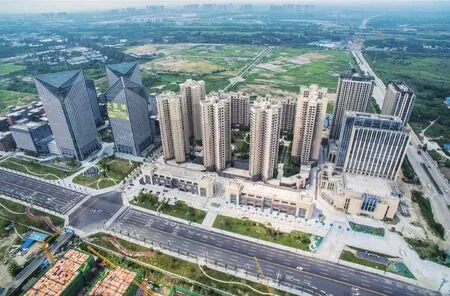
Western Geographic Information Industry Park
Third, China should also endeavor to establish resource complementarity and balanced economic development among regions based on the “enclave economic model.” Eastern, central and western China are encouraged to jointly build industrial transfer parks and promote equity cooperation through merger and acquisition between leading enterprises in eastern coastal regions and those in ethnic regions in western China, and fully leverage the strengths unique to corporate enterprises (such as the sharing of profit and risks, coordinating the interests of transferred enterprises and receiving areas and specific recipients), in order to further empower superior enterprises in ethnic regions in western China. Apart from the “enclave economic model” in which eastern enterprises “branch out in other regions,” the local governments of ethnic regions in western China can also refer to the tactic of “actively attracting enterprises,” in which they sign agreements with their counterparts in the eastern coastal regions for building eastern enterprises-themed industrial parks in western China, and on the cooperation and communication between trans-regional industrial parks concerning industrial agglomeration, talents, projects,management and information. These moves are to seek common development, mutual benefit and a win-win outcome.
(Translator: Wu Lingwei; Editor: Xiong Xianwei)
This paper has been translated and reprinted with the permission of Inner Mongolia Social Sciences(Hohhot), No.4, 2017.
Deng Dacai. (2001). The disequilibrium of institutional arrangement between the east and the west and the institutional innovation in the West.Probe, (1).
National Bureau of Statistics of the People’s Republic of China. (2000).China statistical yearbook 2000. Beijing: China Statistics Press.
National Bureau of Statistics of the People’s Republic of China.China statistical yearbook 2016. Beijing: China Statistics Press.
Peng Gang & Ren Yijia. (2015). Connectivity: National strategy under the New Economic Normal.People’s Tribune(academic front), (3).
The National Development and Reform Commission, Ministry of Foreign Affairs, and Ministry of Commerce of the People’s Republic of China. (2015, March 29). Vision and actions on jointly building the Silk Road Economic Belt and the 21st-Century Maritime Silk Road. Xinhuanet: retrieved from:http://news.xinhuanet.com/fortune/2015-03/29/c_127633221.htm.
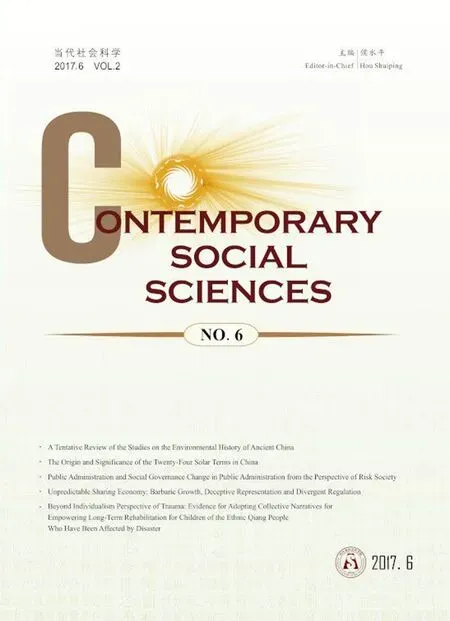 Contemporary Social Sciences2017年6期
Contemporary Social Sciences2017年6期
- Contemporary Social Sciences的其它文章
- Ontological Foundation of Chinese Philosophy on the Implicit Beauty of Images
- Beyond Individualism Perspective of Trauma: Evidence for Adopting Collective Narratives for Empowering Long-Term Rehabilitation for Children of the Ethnic Qiang People Who Have Been Affected by Disaster
- The Slow-paced Development of the Middle Stratum in China:Reason Analysis and Solution
- Unpredictable Sharing Economy:Barbaric Growth, Deceptive Representation and Divergent Regulation
- Change in Public Administration from the Perspective of Risk Society
- A Spatial Turn of Folklore in the Context of Urbanization: From Folk Culture to Mass Culture
